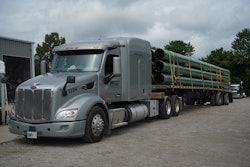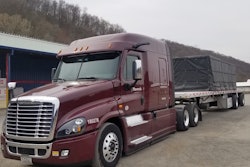Last year, truck drivers finally started getting the recognition they deserve from the public. From #thankatrucker hashtags to people buying meals for drivers at truck stops to a simple thank you on the street, drivers earned praise, recognition and celebration from the public.
For companies that employ drivers, though, the importance of great drivers is nothing new. Truck drivers move 71% of all goods in the United States. They keep the supply chain moving and make sure food and products stay on shelves. Deliveries continue to be made and medical workers get the PPE they need.
Although they were essential throughout the pandemic, COVID-19 caused many drivers to take early retirement, leave the workforce or stay home to avoid the virus (or worse, stay home because of the virus). The American Trucking Associations (ATA) noted that many truck driving schools closed during the pandemic, and 40% fewer drivers were trained last year, meaning fewer new drivers entered the industry – just as the massive pandemic-driven surge in e-commerce began. This so-called “great resignation” is happening in many sectors of the economy, but it is particularly devastating for the transportation and logistics industries.
What does that mean? Fewer drivers available to deliver the goods and returns. Shipping delays. Supply chain backups. Add to that the complex labor market that everyone is facing right now, issues with people not showing up for interviews or work and pay competition across the board, and you can see why so many are having trouble hiring and keeping drivers. That’s why the ATA says the driver shortage could reach 160,000 drivers by 2028 If current trends hold. This is not just an inconvenience. It is a crisis that affects the entire economy.
Centerline Drivers’ annual State of Trucking survey found that 50% of employers surveyed are having a difficult time filling open driver positions. The consequences of not filling open driving roles can be dire, including missed delivery deadlines, decreased productivity and increased costs. And of course, the ripple effect is felt across the supply chain. The research showed that the cost of a truck sitting empty is approximately $500 per day – and half of the companies surveyed had trucks sit for at least one day. Almost a quarter experienced them sitting empty for more than a week.
It’s always been a drivers’ market, but with higher demand for drivers than ever before, drivers can pick and choose where they want to go. So how can your company be the one they choose?
Almost all the companies Centerline surveyed said they were increasing pay. Emsi data confirmed it. Truck driver job wages increased 18% from March 2018 to February 2021 as their importance to the supply chain grew. But with wage parity comes a need to differentiate yourself in other ways, including benefits, incentives, career development opportunities and putting more emphasis on soft skills. Some are also hiring less-experienced drivers or modifying their hiring requirements.
Getting personal with drivers can help, too. Ask them directly what they are looking for and tell them how you can meet those needs. The survey showed many drivers want local routes, steady hours, competitive pay and the ability to have more time at home. But some also would prefer to travel or be on the road for days or weeks. Being flexible and open is crucial.
It’s no longer about saying, “This is the job and this is the route.” It must be a meaningful conversation with a potential driver guided by the ability to be flexible in both recruiting and staffing. It’s also about outreach. As an industry we must try to attract military veterans, women, younger drivers – demographics that haven’t been targeted.
And you can’t forget about retention. Filling a role is only half the battle. The other half is making sure your drivers are happy and want to stay. Drivers like independence, pay and stability, with two-thirds of them saying they want medical insurance or would look for new opportunities if offered better pay. Nearly half want a 401k. And across the board, they want to be treated with respect and feel like a valued part of the company.
Whether it’s driver retention programs, contests or rewards for driving miles or just meals and events that make them feel respected, finding ways to celebrate your drivers will go a long way not only to keeping your drivers happy, but making them ambassadors for your fleet and our industry.
Jill Quinn is President of Centerline Drivers, which connects commercial drivers with customers across the supply chain. Her passion for making a difference in people’s lives by connecting them with work has led to many successful partnerships between customers looking to grow and drivers who deserve great opportunities. She was named to Women in Trucking Association’s (WIT) Top Women to Watch list in 2020 and to Staffing Industry Analysts’ Global Power 150 Women in Staffing list four times.













